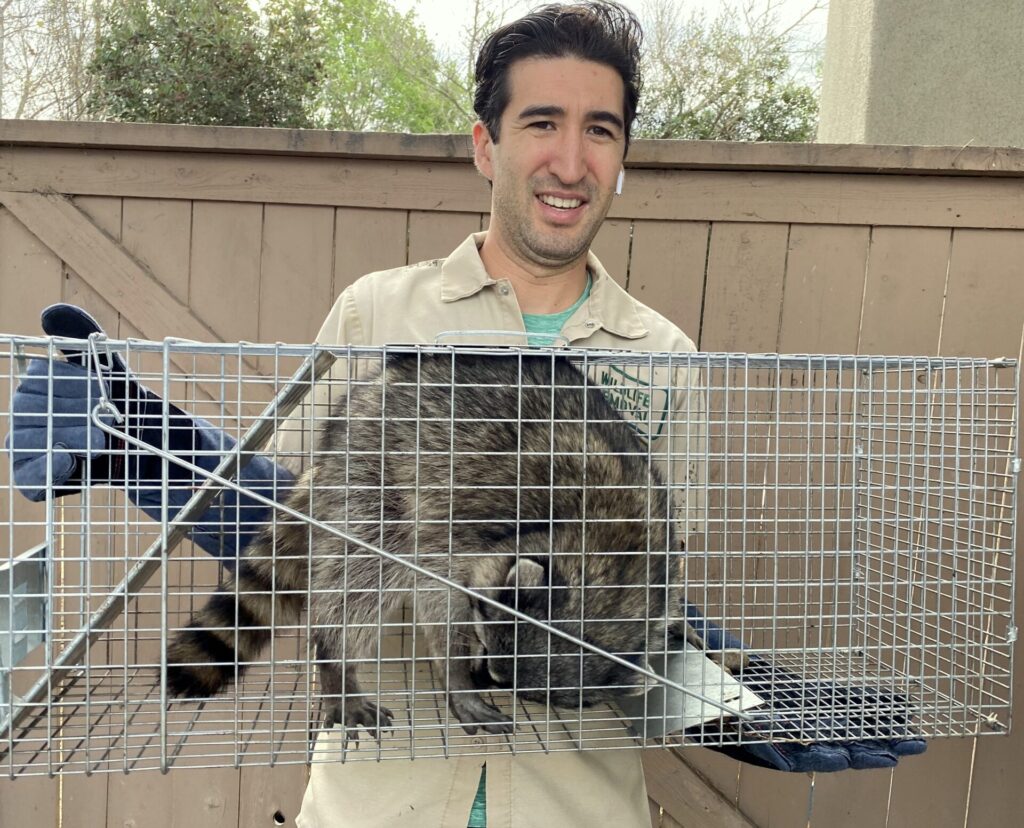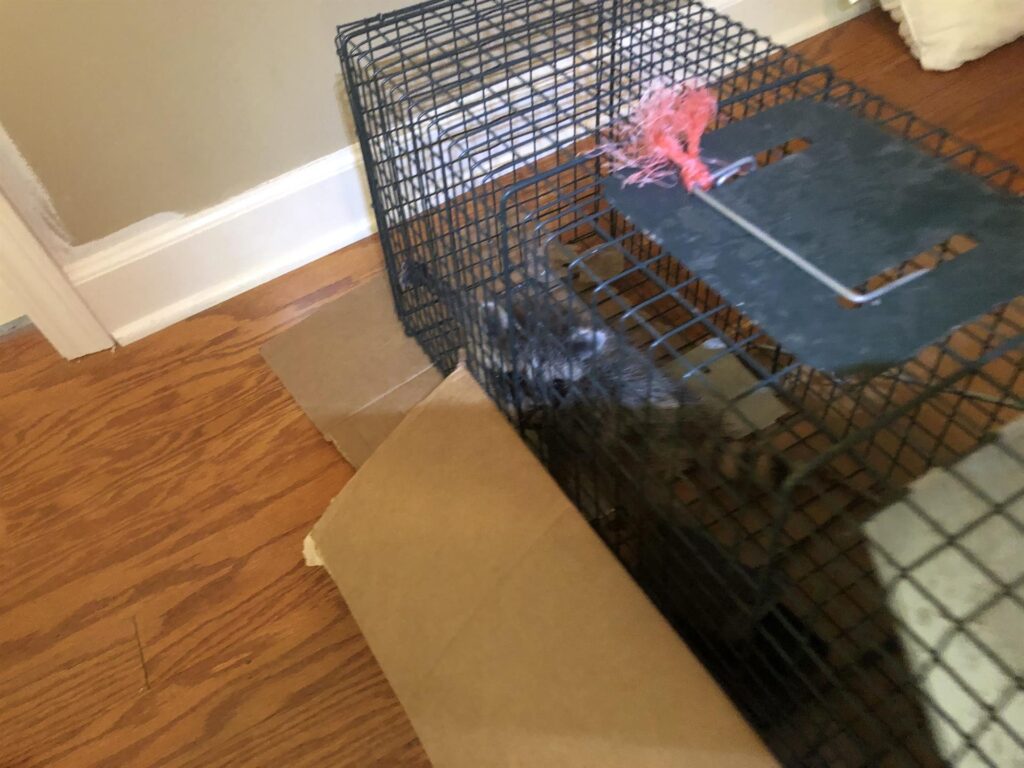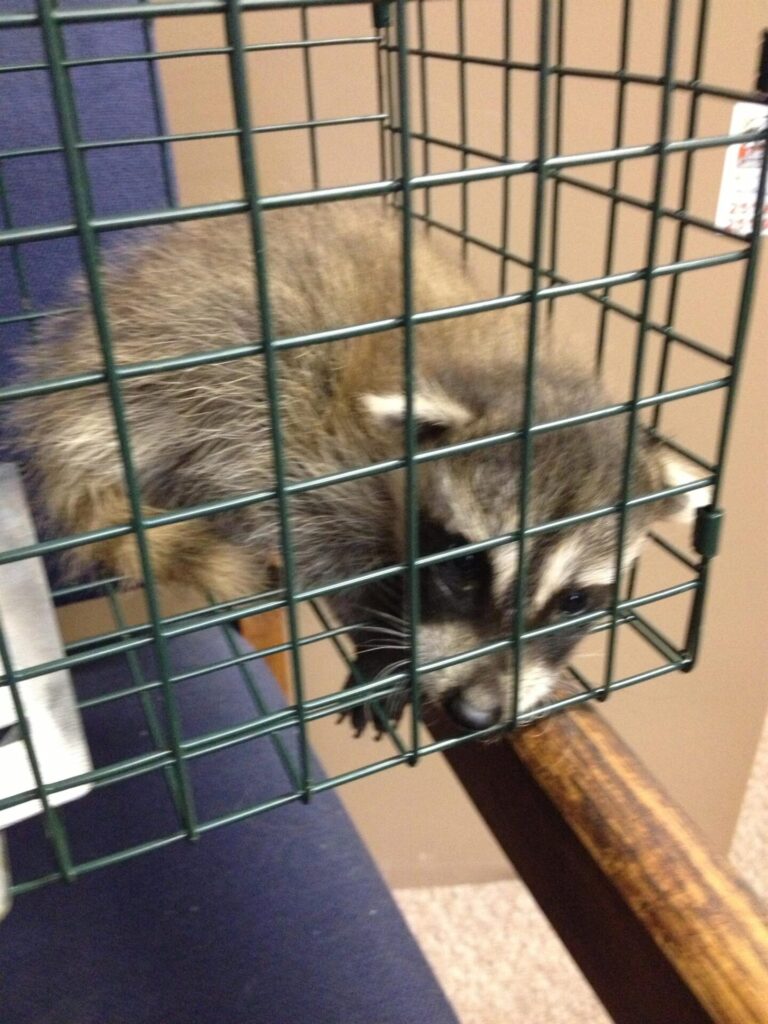Critter Capture Jackson, Get in touch Today For Free Quote
Professional Raccoon Removal
[rank_math_breadcrumb]
Raccoon Removal
Have you woken up in the middle of the night or any other “non-peaceful” evening to the sound of chirping, chattering, or thumping sounds on your floors? Well, if you have, there is a high chance some raccoons have welcomed themselves into your home.
Raccoons are very resourceful animal pests and are second to none in their persistence and creativity to get closer to any food source they mark. Once you suspect their presence , you should contact Critter Capture Jackson.
The resourceful and insufferable nature of Raccoons means that your cozy home, barn, lush garden, or trees are a common and helpless target to them.
How to identify Raccoon infestation/presence
Raccoons are mammals of an average length of 2-3 feet and weighing anywhere between 10 and 30 pounds. They are specially marked by their “masks” on the face-covering separately their eyes and earning them the “bandit” tag. Our homepage (Critter-capture) recognizes them in the picture for their unique behaviors.
Their furry tails and ringed tails may complete their overall cute look, which belies the massive destructive capacity they hold. Their paws are tiny and strong, making them excellent climbers with solid diggers. Here is at pestcontrolraccoon.com a great resource to learn more about raccoon control techniques.
It is also a characteristic of the animal to forage for food at night, making it difficult to see them or the damage they cause.
Other characteristics include;
- Weird smells in the house
- Thumping sounds from the attic
- Scratch marks
- Irregular behavior from a scared pet
- Constant clicking sounds from the chicken or poultry animals
Where you will find Raccoons
Raccoons can endure cold temperatures and even revert to their dens if it becomes too severe. They can be found anywhere in the Americas, from the extreme cold regions of Alaska to Jackson in Mississippi, Alabama, and even the warm areas of Florida. They prefer the moist woodlands building dens in the tree and live near humans.
Raccoon damage
Raccoons don’t just visit human habitations or residential areas to forage for food; they may even begin to form a colony. A group of raccoons will likely take shelter in a property or region they consider to be favorable and filled with food.
Consequently, anywhere Raccoons decide to settle or visit frequently becomes a mess both physically and in terms of hygiene.
Some of the damages Raccoons cause include;
- Diseases
Spending considerable time in the wild or outside the grid, Raccoons can quickly spread many diseases they contract. The disease Raccoons is dangerous to humans and other animals nearby (including pests). The Centre for Disease Control warns that the disease such as rabies they carry is still hazardous to humans.
- Aggression towards other animals and pets
There are records of diseased Raccoons chasing other animals or even a human. It is also likely that a mother Raccoon is more aggressive towards humans or other pets.
Raccoons also attack bird/chicken feeds and nests and kill and eat younger fowls.
- Physical activity in the property
Raccoons can go any length and endure any obstacle to get to a food source. This makes them great in burrowing or digging the ground of your gardens in search of worms. In severe infestation cases, it is common to spot haphazard burrowing and holes in your gardens or property.
Raccoons also commonly attack warehouses or farmlands and destroy food stock by leaving the half-eaten stock. And they can be annoyingly wasteful on several foods and will eat almost anything (plants and animals alike).
- Disturbances, noises, and Chattering
Just like bandits, you don’t need any confirmation when Raccoons are nearby. There will be lots of tapping, screeching, chattering, chirping, growling, and other strange sounds. The more the numbers in their group, the noisier it gets, and most times, you hear the discordant sound of paws against the ceiling.
- The stench from the infestation
Raccoons also have a characteristic smell, especially where they lay their droppings. Aside from the unpleasant stench, the droppings are breeding conditions for other worms, insects, and flies.
Also, since Raccoons primarily emigrate from the wild, they are prone to carry other more minor pests and insects. Some of them include Ticks, worms, and other smaller parasites.
Removal of Raccoons
It is easier and better to prevent Raccoons from entering your properties than get them out. However, there is no Raccoon problem that is too difficult to solve. Although it can get tricky. You can temporarily keep Raccoons at bay using;
- Rodent traps
While this will not be an aggressive removal method, it may deter others from a particular area. Traps can be buried in strategic and alluring areas for maximum effect.
- Pesticides
There are lots of chemical substances that may repel Raccoons; some are even homemade. In addition to the common pesticides, the frequent addition of Garlic and Chilli pepper can be a deterrent to the animal.
Depending on State laws, it is illegal (as well as inhumane) to poison raccoons.
- Use Scarecrows
Raccoons are usually cautious of being sneaky or running around humans. Some common suggestions are to
- Hang up a radio in the garden
- Make a large dressed dummy
- Put lights in the garden or any dark area
Raccoon prevention
There is no one method to prevent Raccoons, depending on the peculiarities of your property, take any means to ensure raccoons cannot access your property or food stock.
Some ways to prevent Raccoons include;
- Sealing up all holes, including open chimneys, pipes, cracks, and so on.
- Using repellents and other materials to coat particular areas around the property,
- Clearing up the trash at regular intervals
- Build a good and high fence around the garden, without branching sides
However, please do not beat yourself about it no matter what you do. Raccoons can be very stubborn and impossible to clear out. Your best bet is to settle for professional services/
Critter Capture
Understanding how painful and challenging pest infestations are, we offer a meticulous and prompt service to taking out pests and other rodents, including raccoons. While we consider pests harmful and problematic to humans, we understand their importance to the ecology.
Our modern and nonfatal pest control methods have rewarded us with numerous clients around Alabama, Jackson, Mississippi, and Louisiana Gulf Coast.

How to Remove Raccoons from the Attic?
When dealing with wild animals, raccoons are some of the most annoying – although they’re oftentimes adorable little creatures when they scurry by your yard or home, they can quickly become much more annoying once they’ve decided to stop by and make your home their home.
As one of the most common urban animals across the United States, and the world, you’ll likely come across more than one attic-bound raccoon over the years. While it might seem simplest to just let the little animals stay in your attic for a bit until they leave, that solution isn’t good for you nor the raccoons. So, like that, how can you remove raccoons from the attic?
Make Sure They’re Raccoons
One of the first things you need to do is make sure that the animals in your attic are raccoons. There are quite a few animals that find their way to the attic, whether that be squirrels, mice, rats, bats, chipmunks, or raccoons.
Each one has a similar need to be taken out of an attic, but the way you do so is quite different. As such, just take a bit to ensure that you’re dealing with raccoons – that might mean calling the professionals to check it out or looking for a few key signs.
Raccoons have a few lookalike signs to other animals, although they’re still important things to look out for. These might include feces around the attic area, scratching, snarling, or chewing noises, pawprints, holes in vents, footprints in the attic, dirt around your home, or just seeing raccoons as they come and go. Each of these points a little further towards your mystery animal being a raccoon and makes the next steps a little easier.
Removing a Raccoon
When it comes to removing a raccoon, there’s really only one successful way to do so – trapping. While that’s not necessarily the end-all-be-all, it’s one of the most efficient, effective, and cheapest solutions while also making sure that you don’t injure the raccoons.
Unfortunately, however, traps don’t work for every situation; families of raccoons are a big no-go when using traps. Baby raccoons are incredibly fragile animals, and the slightest bit of anxiety or fear could literally kill them. If you see or hear any raccoon pups in the attic or find a defensive mother raccoon, then immediately ignore the next steps, and call a professional.
Otherwise, you’ll need to locate the entrance to your attic as soon as you can. Being careful (and safe), look for vents, openings, damaged walls, or other spots that a small raccoon could pass through. Not only does this help you spot a raccoon, but it also gives you information into recovery and prevention down the road.
Nonetheless, once you’ve found the spots that a raccoon might have entered from, trap off all but one entrance, carefully, if you’re confident there aren’t any baby pups. Leaving one entrance allows you to place a cage trap, leaving only one exit (and trap) for all the raccoons to enter. With this tactic, even if you can’t capture all of them at once, you can rinse and repeat until everyone is relocated.
What Next?
Well, once you’ve captured all the raccoons in a cage, do one of two things: call animal control or a licensed expert nearby, or look online at local regulations and see if you can leave the animals a few miles from your home, safely.
Once everything’s done, you’ll need to block off and reenforce the entrances to your attic which the raccoons might have entered via, cleaning and disinfecting everything afterward. There’s a lot involved in removing a raccoon from an attic, so while it might seem simple, it’s important to note that little mistakes can ruin the whole process.
That’s why we recommend, if you have any issues, to call animal control or a local removal company. Things can go south quickly, especially with potentially disease-carrying mothers defending their pups. It’s not worth the chaos…
How to Remove Raccoons from Attic?
Having a raccoon in the attic is one of the most common wildlife infestation problems. Raccoons instinctively seek out warm and safe shelter, so if there’s an opening, do not be surprised if raccoons take advantage of that.
Unfortunately, raccoons in the attic are problematic because of the several problems they cause – from ripping apart the insulation to spreading pathogens through their feces. And with their squeaking and constant movement in the attic, it’s almost impossible to have peace of mind in your home.
Over the decades, Critter Capture Jackson has helped countless homeowners bring an end to their raccoon infestation problem. And in this post, we share with you how to remove raccoons from the attic.
Signs of raccoons in the attic
Do you suspect having raccoons in your attic? Here are some signs to look out for:
- Attic noises, like chewing, snarls, and scratching
- Sighting of a raccoon going in or coming out of your attic.
- Feces inside the attic. Raccoon feces are similar to dog feces with undigested food in them.
- Dust footprints in the attic
- Pawprints on woodwork.
- Holes in the foundation vents.
Removing raccoons from the attic
Follow these simple steps to get rid of raccoons in the attic.
Step 1: Thoroughly inspect your attic
The first step of the removal process is inspection. This stage is crucial because it helps you understand the problem’s severity and develop an effective removal strategy. Look out for signs of a raccoon infestation. Check to see if there are baby raccoons in there. You see, mother raccoons will sometimes move into your attic to give birth to their babies in a warm and safe place.
Also, examine your attic to check out potential entry holes. Raccoons take advantage of these holes to gain access. Is there a missing roof tile? Is there an opening beneath the soffit?
Step 2: Develop and implement a removal strategy
Now that you have a solid grasp of the problem, it’s time to develop a removal plan. There are two practical approaches to raccoon removal, depending on your unique circumstances. They include:
- Exclusion
This is the most humane method of raccoon removal, and we highly recommend it at Critter Capture Jackson, particularly if you have only adult raccoons living in your attic. All you need to do is seal up all the entryways into your attic with caulk or hardware cloth, except one. In this last hole, install an exclusion device. An exclusion device (or one-way door) allows wild critters in the attic to leave without being able to get back in. After installing the exclusion device, wait for a couple of days. Eventually, all the raccoons in the attic will leave in search of food and be stuck outside.
- Trapping
If you have baby raccoons in the attic, installing an exclusion device risks separating the mother from her pups. Eventually, the abandoned babies will die of starvation and, in time, give off a putrid smell and spread pathogens. You’ll then have a bigger problem to deal with. That’s why you never install an exclusion device when you baby raccoons in your attic.
Instead, trapping is a better option. You can handpick the pups when the mother is out and use them as bait in a live trap. Once the mother returns, she is forced into the cage to reach her kits. The mother and her kits can then be relocated. Adult raccoons in the attic can also be trapped.
Step 3: Clean up and Decontamination
After getting rid of the raccoon, you’ll have lots of mess. Before cleaning up, wear protective clothing like overalls and gloves to prevent health hazards. Pick up shredded insulation, wires, and other materials. Moreover, scrap all droppings into a plastic bag and dispose of them properly.
After thoroughly clearing the entire area, it’s crucial to decontaminate to kill off pathogens. This can be done with an enzyme-based cleaner. You can also deodorize your attic to get rid of foul smells.
Step 4: Perform necessary repairs
Raccoons are very destructive creatures; hence you’ll also need to repair all the damages done. This may include replacing the attic’s insulation, wiring, or wood. But most importantly, seal up all entry holes and reinforce vulnerable spots so other raccoons won’t be able to come into your attic.

